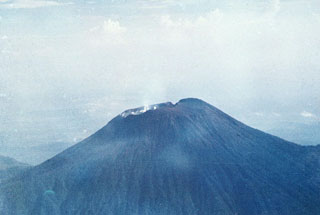Report on Slamet (Indonesia) — 27 September-3 October 2023
Smithsonian Institution / US Geological Survey
Weekly Volcanic Activity Report, 27 September-3 October 2023
Managing Editor: Sally Sennert.
Please cite this report as:
Global Volcanism Program, 2023. Report on Slamet (Indonesia) (Sennert, S, ed.). Weekly Volcanic Activity Report, 27 September-3 October 2023. Smithsonian Institution and US Geological Survey.
Slamet
Indonesia
7.242°S, 109.208°E; summit elev. 3428 m
All times are local (unless otherwise noted)
In a 2 October press release PVMBG noted recent inflation and increased seismicity at Slamet. In 2023 seismicity was dominated by earthquake signals indicating movement of fluids around the surface and gas emissions, and these signals averaged 168 per day. Gas emissions rose 25-300 m above the summit. During 24 September-1 October there the number of local tectonic earthquakes increased followed by an increase in tremor amplitude. Tiltmeter and Electronic Distance Measurement data from the Cilik station located at an elevation of 1,500 m showed inflation while another station (Buncis) showed deflation; the Jurangmangu station located at a lower elevation that Cilik showed no significant deformation pattern. The Alert Level remained at 1 (on a scale of 1-4) and the public was warned to stay outside a 1 km radius.
Geological Summary. Slamet is one of Java's most active volcanoes. It has a cluster of about three dozen cinder cones on its lower SE-NE flanks and a single cinder cone on the W flank. It is composed of two overlapping edifices, an older basaltic-andesite to andesitic volcano on the west and a younger basaltic to basaltic-andesite one on the east. Gunung Malang II cinder cone on the upper E flank on the younger edifice fed a lava flow that extends 6 km E. Four craters occur at the summit of Gunung Slamet, with activity migrating to the SW over time. Eruptions recorded since the 18th century have originated from a 150-m-deep, 450-m-wide, steep-walled crater at the western part of the summit and have consisted of explosive eruptions generally lasting a few days to a few weeks.
Source: Pusat Vulkanologi dan Mitigasi Bencana Geologi (PVMBG, also known as CVGHM)

